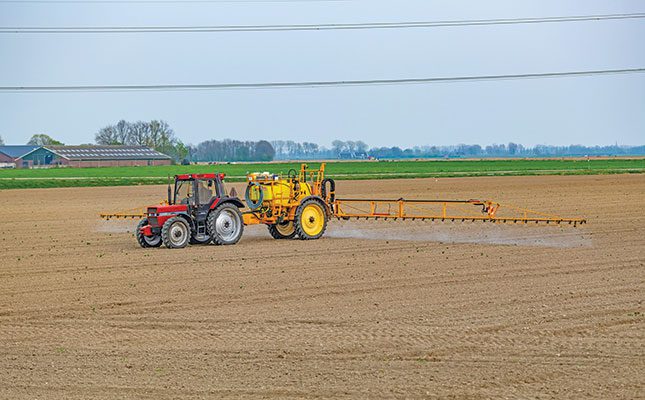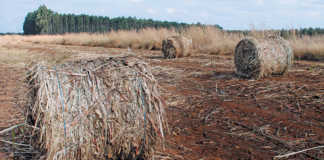
Photo: Flickr
Chemical remedies used in agriculture can be classified as being of natural or synthetic origin and are used to keep crops, livestock, poultry and pets free from pests such as insects, fungi and bacteria, as well as fungal and viral diseases and weeds.
Common agricultural chemicals (agrochemicals) include insecticides, herbicides, fungicides, adjuvants, fertilisers and veterinary chemicals.
Agricultural chemicals may be purchased in various concentrations and forms such as liquids, powders, granules and pellets, depending on their intended use. Widespread use of agrochemicals necessitates the need for regulating these products.
“Regulations should be in place to protect not only the crops and animals, but also the health of workers handling plant protection solutions, the environment and consumers,” Rodney Bell, CEO of CropLife South Africa (CropLife SA), said during a media briefing held recently.
South Africa has a very strong regulatory environment for pesticides, which is mostly guided by the Fertilizers, Farm Feeds, Agricultural Remedies and Stock Remedies Act (No. 36 of 1947) and its accompanying regulations.
The purpose of the Act is to regulate the registration process, importation, manufacture, sale and use of fertilisers, farm feeds and agricultural remedies. The Act relies on support of other acts such as the Hazardous Substances Act (No. 15 of 1973), the Trade Metrology Act (No. 77 of 1973) and various other industry standards.
Strict control
All agricultural chemicals need to be registered by the office of the Registrar of Act No. 36 of 1947 and no one may sell products on the local agricultural market if these are not registered in terms of the various provisions detailed in the Act.
“To bring a new product to market, we need multiple years of field trials to generate data in different climatic regions of the country before an application can be brought to the registrar’s office,” Bell explained.
“It takes at least seven to eight years for a company to conduct their field trials on a single product, compile a registration dossier, submit it to the regulator and finally receive authorisation for the sale and use of the new technology. All these requirements and years of data collection amount to billions of rand spent on research and development.”
It was in this environment that CropLife SA fulfilled its purpose, Bell said. “We enable our members to be providers of environmentally compatible solutions that ensure sustainable, safe and affordable food production, and therefore food security, in South Africa. We are also the leading industry voice on behalf of our members in matters pertaining to crop protection and plant biotechnology in South Africa.”
CropLife SA membership is voluntary, but requires a commitment to abide by the association’s code of conduct, which includes adherence to all statutes of the country. Members receive exclusive benefits such as Agri-Intel access, participation in working groups, forums, training and the Continuous Professional Development (CPD) programme, as well as access to up-to-date industry information and resources.
According to Bell, CropLife SA serves responsible manufacturers, suppliers and distributors of sustainable crop protection, public health and plant biotechnology solutions in South Africa.
“About 90% of all agricultural remedies sold in South Africa are sold by CropLife SA members.”
There are various ways in which CropLife SA serves its members, and thereby also the broader industry as well as the general public:
Agri-Intel
Agri-Intel offers easy access to a comprehensive database of crop protection products registered for use in South Africa, including product labels, safety data sheets, and information on maximum residue limits and withholding periods.
Continued professional development programme
CropLife SA’s CPD programme aims to promote ongoing learning in the industry, ensuring that participants stay up to date with the latest relevant knowledge to obtain and maintain their CropLife SA compliance.
Basic Crop Protection course
This online course provides an overview of the crop protection industry and aims to set a minimum standard for people active in the industry. The course comprises four modules and a final assessment. Students can enrol at any time during the year and complete the course at their own pace, provided it is within a 12-month period.
The Genetically Modified Organisms Act (No. 15 of 1997) provides regulatory oversight to ensure rigorous safety assessment of biotech crops. CropLife SA acts as liaison between the Department of Agriculture, Land Reform and Rural Development and the plant science industry in order to ensure compliance with and enforcement of this Act.
In addition, CropLife SA offers the following benefits to its members:
- It monitors and updates members on plant biotech policy developments.
- It supports members with regulatory compliance, such as GM labelling, and procedures and processes for GM cultivation and trade.
- It communicates regarding outreach activities and product stewardship issues.
“There are many pressure groups that believe we can feed the world without the use of pesticides. These groups are placing immense pressure on regulators not to register certain new products and to deregister certain existing products,” Bell said.
He added that it was crucial that regulators, farmers and consumers should refrain from listening to misleading information and half-truths.
“All decisions should be based on recognised, peer-reviewed data. Careful thought is necessary when deciding which pesticides to withdraw and keep from our producers.”
Bell also referred to a study conducted in the US that indicated that the yields of most fruit and vegetables would decrease by between 50% and 90% without the use of fungicides.
“Without the use of chemical remedies, the production of these essential food groups would be extremely expensive due to lower yields and quality, and most probably unaffordable to most consumers,” he said.
Bell added that while the EU’s safety strategies were cause for concern, it was not entirely out of line with CropLife SA’s strategies to convince more South African producers to adopt integrated pest management (IPM) principles.
“The adoption of IPM makes sense from the perspective of primary food producers, as well as consumers, workers handling plant protection solutions, and the environment.”
Difference between hazard and risk
The aim of using any pesticide or agricultural remedy is to kill undesired organisms. This is, however, used by the uninformed and lobbyists as a tool against the use of pesticides.
All chemicals are classified into categories based on their hazard, amongst others acute and chronic oral toxicity, carcinogenicity, mutagenicity, teratogenicity (causing birth defects), and endocrine disruption potential.
“Understanding the difference between hazard and risk is a valuable tool to instil a sense of responsibility into people who use pesticides and also to address the public’s fears of pesticides. Yet, very few people understand the difference between risk and hazard and many authorities and regulators evaluate chemicals based mostly on hazard,” Dr Gerhard Verdoorn, operations and stewardship manager at CropLife SA, said.
Any chemical, of whatever nature, may pose a risk to a live organism of whatever species if such an organism is exposed to that particular chemical. Exposure may refer to oral intake, dermal contact (and uptake) or inhalation. Risk is a manifestation of the hazard when an organism is exposed to a chemical at a dosage that will elicit a response.
“Hazard and risk may be explained in terms of an example. Every home has a kitchen with knives, which are hazardous objects, but while kept in their drawers in the kitchen, they pose no risk. But, while preparing food with a sharp knife, there may be a risk if the knife is not used according to the prescribed methods and skill. When a child gets hold of a knife, the risk escalates dramatically. The same principle applies to the use of chemicals,” Verdoorn said.
Explaining the difference between an acute rick and a chronic risk, he said that when an organism was exposed over a short period to a high dose of a chemical, this was an acute risk, whereas a very low dosage exposure over extended periods of time was a chronic risk.
“Toxicologists are often concerned about long-term exposure to risks, where an organism is in contact with very small quantities of a chemical over an extended period. Generally, a single intake of 5g of aspirin is hardly of concern, but 2g per day taken every day over a long period spells a high risk for renal toxicity in the long term and corrosion of the stomach lining.”
Safety precautions
All pesticides are required by law to have a corresponding safety data sheet, which gives valuable information on how to safely handle the chemical. In addition, the product should come with a label containing the usage instructions.
Verdoorn gave the following advice regarding the safe use of chemicals:
- Be responsible when using a chemical product.
- Don’t use chemicals excessively.
- Before using any chemical, read the label and follow the usage instructions. Read all the instructions on the chemical’s container and follow them diligently, especially when preparing tank mixes.
- Don’t use chemicals when not really required, such as filling a room with an aerosol mist to kill one mosquito.
- Store chemicals in a safe place out of reach of children and pets. A benign compound is a potentially high-risk weapon in the hands of an uninformed, irresponsible or careless person.
- Wear the appropriate protective gear.
- Train the people that will be responsible for the applications properly.
“If the pesticides are used strictly according to label instructions, I maintain that the risks are manageable, if they exist at all. However, the risks escalate if the label directions are not adhered to,” Verdoorn said.
Email Dr Gerhard Verdoorn at [email protected].











